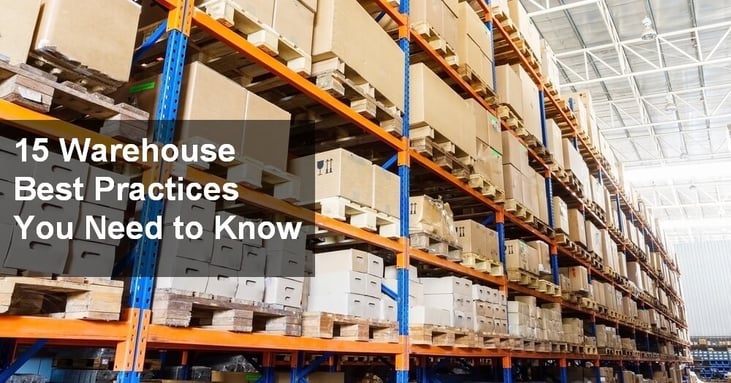
As a business owner, you want to make sure that your operations run as smoothly as possible so that you can be as successful as possible. However, when it comes to running a warehouse, many times there are issues that arise that could otherwise be prevented if the operational side of things was more streamlined and productive.
To help you achieve success, we want to provide you with a list of best practices that will ensure that you mitigate any problems before they can derail your operations. While this is not a complete list of actionable items, it should give you a great idea of where you can make the most improvements to turn your warehouse into a thriving business.
#1 Automate Your Data
When you’re having to track and move thousands of pieces at a time, you will inevitably have to deal with human error every so often. This is only compounded if you have your staff enter numbers manually into a system. Even if you are technically automated on the back end, your data collection should be automated so as to remove the possibility of error as well as cut down on your time. Utilize systems like RFID tags and scanners so that you never have to worry about someone misentering in a product label or number.
#2 Make Your Data Visible
If only one or two people have access to your back of house system, then that means that you could potentially experience problems if they aren’t paying attention. Instead, make your system much more accessible so that staff, supervisors, and managers are all looking at it and can ensure that things are running smoothly. Also, it cuts down on communication delays since everyone can see what’s going on in real time.
#3 Sync Your Data
While data collection is a huge part of your operations, if you aren’t able to analyze it and use it for forecasting and tracking, then it doesn’t do much for your business. The best thing to do is create a comprehensive back of house system that incorporates your information and provides real-time analysis. This will also help you identify weak points in your operations and help you streamline the process.
#4 Track Your Inventory
If you don’t know where all of your products are at any given time, then that means you will have to hunt it down later. This is another part of having an interconnected system as it will show you where your inventory is, when it needs to be moved, and when it’s shipped.
#5 Avoid Procrastination
No matter how busy things get, you don’t want to avoid following certain procedures because you’ll get to them later. This will always create backups down the line that could have even more dire consequences later on. As such, take the time to handle all procedures as they happen so that you aren’t scrambling later.
#6 Make Returns More Efficient
Because the process for returning products and inventory can be complicated, you want to implement a system that makes everything much more efficient. Organization and planning will help ensure that when returns happen it doesn’t severely impact your daily operations. You should be able to handle returns without bogging down your regular duties.
#7 Use Advanced Shipping Notifications
If you’re not getting notified when your inventory is en route, rather relying on a “regular” shipping schedule, then you are setting yourself up for failure. Delays happen all of the time, so if you aren’t aware of it beforehand, then you are left waiting for an arrival that may be substantially late. ASNs help you strategize your operations so that when a delay occurs, you can respond accordingly and minimize your downtime.
#8 Eliminate Waste
This is both true for physical waste and labor. If you can streamline certain operations and reduce the number of staff it takes to get the job done, then do it. Make your operations as lean as possible without sacrificing quality of service.
#9 Do an ABC Analysis
This method will prioritize your inventory based on what is most valuable. This way you can make sure to utilize your time and labor effectively to increase your returns. Without this analysis, you might be spending equal amounts of time and effort on items that are of unequal value.
#10 Use an Ongoing Cycle Count
In some cases, it’s better to keep track of your inventory on a rolling basis than having a comprehensive system that needs to be regularly updated. This will minimize the amount of time you spend tracking and collecting data and can keep your operations on point.
#11 Slot Products Efficiently
Most of a picker’s time is spent in transit, either by walking to a stack or riding a forklift. If you can minimize that travel time, even by a couple of minutes, then you can save a lot of time and effort in the long run. Do so by making your stack layout more efficient and accessible.
#12 Utilize Cross-Docking
This process is when you offload product from one truck and then put it on another. This will save you a lot of time because you don’t have to store the inventory in the warehouse. Use this procedure as much as possible so that you can keep your operations flowing.
#13 Implement Strict Safety Measures
If an accident happens at work, it can cause massive delays. Thus, to mitigate any problems, you want to keep a safe work environment. Make sure that staff is not cutting corners or practicing unsafe procedures. Even if it’s to save a little bit of time, the risk is far too great.
#14 Plan Ahead
It should go without saying that you should keep your warehouse as organized as possible and plan out as far as possible so that you can make sure that you’re on track all the time. If you don’t stay organized, then it’s easy for things to start to get messy and you will experience delays and setbacks as a result.
#15 Train and Retrain Your Staff
Finally, make sure that all staff members are properly trained on all operations, and also ensure that they perform tasks for which they were trained. It’s much better to take the extra time to get your staff up to speed before they hit the floor rather than having them learn as they go.












